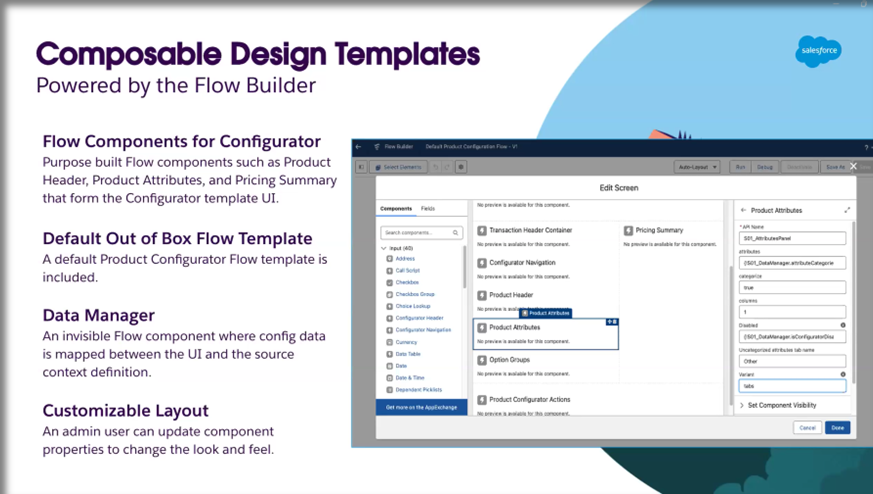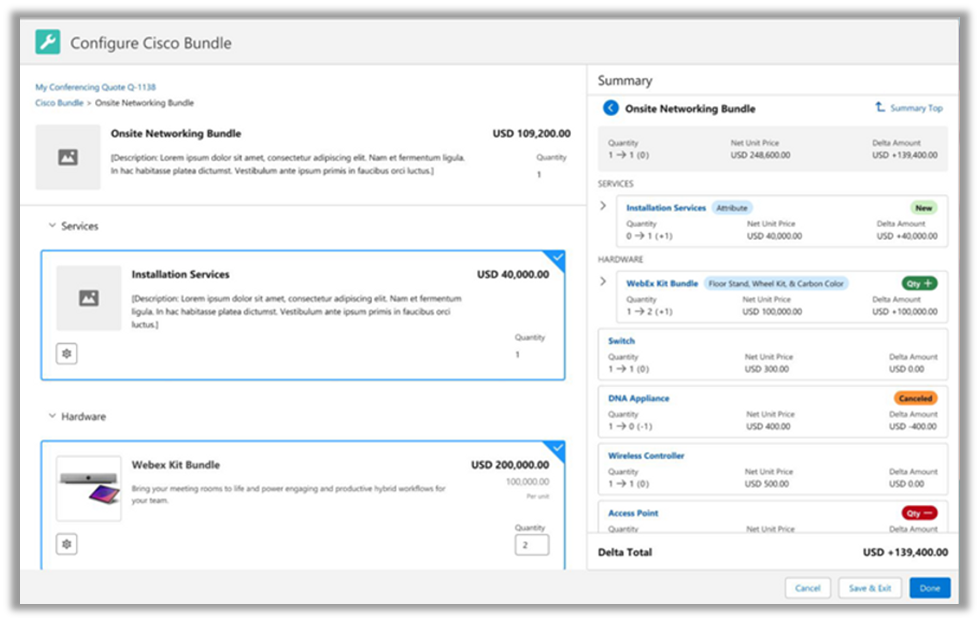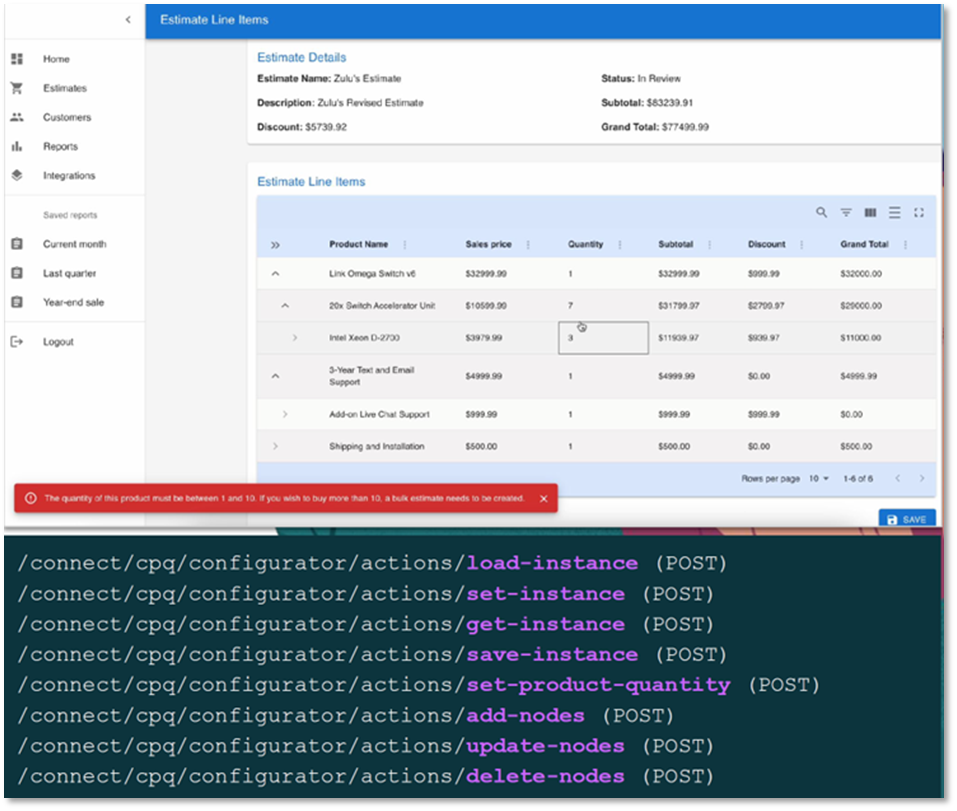Let’s explore the Product Configurator in Revenue Lifecycle Management.
Why product configurator
Intelligent
It provides an intuitive configuration experience featuring dynamic rules, product validations, real-time pricing, and AI capabilities to boost sales.
Extensible
It offers extensibility through headless APIs, custom field mapping, UI templates, configuration rules, and pricing procedures, enabling it to adapt to diverse business needs.
Scalable
Designed with a high-performance, scalable rules engine, pricing engine, and catalog management, it supports complex configurations even at large volumes.
Introducing Salesforce Product Configurator

- Composable Design Templates Easy to manage configuration Rules
- Intuitive Runtime experience Headless APIs for 3P Integration
The product configurator predominantly works with different personas, such as product catalog administrator, configurator administrator, and on the other hand, sales rep in charge of selling.
Let’s learn about product configurator in terms of design time (administrator) as well as run time (sales representative) perspective.
Design Time Configuration
Customizable Templates
Every component of the Salesforce Configurator has multiple components, and these components are purposeful. The entire shell of the configurator is nothing but multiple components put together.
Preview & Assign Templates
Once we have a template design as a catalog administrator, we need to assign that to certain products.At runtime, the template assigned to your product gets launched.
Configuration Rules
The administrative side covers how configuration rules are created and the constraints that can be applied. Everything necessary to ensure that products are configured accurately and consistently is managed through these configuration rules.
Configuration Run Time
Once the configurator is designed, it’s handed over to the sales rep. They’ll take it out in the field and begin using it to build and sell items.
Instant Pricing
As you build the product, you can instantly see the price associated with it.If multiple products are being added, the pricing will be influenced by the products getting increased based on the changes we make.
Configuration Summary Overview
The configurator is a visual tool that every sales rep will use.
It needs to be intuitive, allowing sales reps to quickly review and access all the information necessary to sell the product to their customers. This is the essence of how the product will be built.It provides sales reps with a clear representation of the product being configured, along with key attributes and pricing details.
Real-time product validation
A configurator is a tool that ensures we are building the right products.It validates that certain products are fully compatible and ensures that only the correct products are sold through comprehensive product validation.
Actionable Error Messages
When validating a product, it’s important to provide a prediction if something goes wrong or if products are not compatible, typically through an error message.A configurator’s runtime empowers the sales rep to sell the right products with the correct configurations.
Key features of SF product configurator
Composable Design Templates
The composable template is a tool provided to admins to stitch together the configurator experience. This is done using the elements on the design template.
It’s important to understand its functionality—it’s quite powerful. With it, we can see how attributes are rendered at runtime.
We can configure the product header and pricing summary based on the requirement.
Based on the requirements, we stitch all the elements together to create a clear visualization.
If needed, we can plug and use them in the flow template as well.
For example, let’s consider Google Maps. If we place Google Maps in a flow template, we can see Google Maps in the configurator at runtime.
An admin can update the flow template to change the look and feel.

Configurator Template Assignment
Once the template is designed, it needs to be assigned. Without this association, it serves no purpose. These templates are assigned to products or product classifications. Salesforce provides an out-of-the-box configurator that is the product configurator flow.
Selling Experience
Configure Products
Easy selection of attributes and quantity for simple and bundled products organized within component groups.
Price Visualization
Instant/on-demand pricing is available at the time of configuration, along with details of the various pricing elements.
Product Validation
Quick sanity check of the product being configured at runtime along with appropriate user messages for correction.
Multi-level Navigation
Capable of rendering a complex product bundle with up to 5 levels of structure and supports easy navigation among those levels for configuration change.
Configuration Rules
Offers an intuitive configuration experience with validation, inclusion, and exclusion rules to apply business logic in the time of sale.
Configure from Orders
Ability to configure products from orders by launching the product configurator.We can launch configurator from quote, orders, and the browse catalog experience.
Amendment Configuration
Configurator is not only enough for initial sales. There are organizations that sell subscription products.
Renewal and Amendment
There are configuration experiences where we can do cancel, quantity update, upsell, and reduce quantity.
In the case of reconfiguration, we have indications of “What’s my delta pricing?”
For example, if in the previous cycle we were purchasing for $10,000, now with additional products, what’s my delta pricing?

Amend Asset and Reconfigure
Ability to amend an existing asset and update its quantity/attribute, and quickly price and validate the same.
Intuitive UX to View Changes
Enhanced summary component with labels to view changes/delta pricing amounts during the amendment workflow.
Cancellation
Ability to cancel an asset from the configurator with proper user confirmation.
3rd Party Configurator Support
Launch External Configurators
Salesforce is providing a framework to integrate with 3rd party configurators.
There are requirements that need plug-and-play widgets, allowing a callout to an external configurator which takes one part of the entire configurator and gives us the required result as needed.
Integration
Seamless integration with 3rd party configurators
Custom Configurator UI Widgets
ISV vendors can develop custom widgets using the LWC (Lightning Web Component) platform.
Coexistence of 3P and 1P Configurators
Ability to associate certain product classes to external 3rd party configurators, done via Flow template association.
Headless Config API
In Salesforce, we have a vast list of APIs that are generally available. When stitched together, these provide a product configurator experience. The 3rd party users can build their own UI on top of these APIs and have the complete configurator experience.

Config APIs Covering All Config Actions
A granular-level headless API, covering actions such as load instance, save instance, set quantity, add/update/delete nodes.
Headless APIs to support 3P Integration
Customers can choose to have a custom configurator UI while leveraging the full benefit of Salesforce product configurator APIs as the backend.
Orchestration of Business Process
Our config API is a process orchestrator that governs various processes during a configuration session, such as product qualification, product cardinality configuration rules, and pricing invocation.
Conclusion
The Product Configurator itself has a notable look and feel/UI/UX difference from what we get with the out-of-box LWC Cart experience in Industries CPQ. However, the concepts behind the scenes are quite similar, including the ability to bring your own UI with Third-Party Configurators, analogous to guided selling Omni Scripts. On the rules side, we see Industries CPQ’s Advanced Rules heavily inspiring Revenue Cloud’s Configuration Rules. Finally, on the data model, Revenue Cloud and Industries CPQ follow the same approach of using the standard Quote and Order objects.

